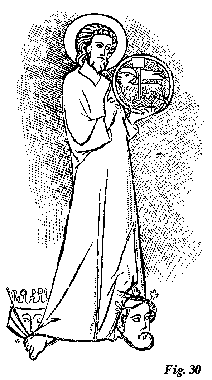498 APPENDIX TO PART II
Lamb of God; while with the other, he pointed to the sacred object of his mission. A calm and holy serenity beamed around the features of the martyr, and though walking in triumph upon the heads, he still appeared divinely unconscious of the fallen and prostrate condition of his murderers. There was a peculiar expression, too, in the face of Herodias. She appeared to be too much astonished to be in pain. “I thought I had his head in a charger-it is not so!-he has mine at his feet for ever and ever.” Now, which of these illuminations told the story in the best manner-the man in the meadow with the book 
27. So much for the recommendation of outline. He now came to the more practical question of how to acquire it. In a letter published in the Builder,1 one of his pupils objected that he had referred to them for help in carrying out his idea. The help he had asked was that they should inform him at what price such ornamentation of walls and books and shop-fronts as he had suggested could be executed. If he went to an artist and asked him for how much he could paint a picture two feet by two feet six inches, he should think it strange if he received for answer that it was not a practical question. All he wanted from the workmen was to know at what price the work could be done, and what he wanted to tell the workmen was how to do the work. Than this there was nothing more easy and simple. To those who had the gift and the liking-and those who had the gift would have the liking-he would say, Take a blunt pen, and common ink, and. draw with it everything, every figure, that came in their way, observing, however, these two important points: that no line was ever to be drawn loosely, without a meaning or a use; and that every characteristic shade or local colour, or stains that might be useful when they came to fill up with colour, were to be carefully noted. As in the bird he had exhibited, the pupil of the eye must be observed and marked, and also the black legs. Everything must be noted that could be useful in filling up with pure colour afterwards. If they drew a lion and a leopard, the leopard must especially be marked as a spotted creature. In everything they did they must note the local, not the accidental, colour.
28. After observing that the specimens which he had produced would remain at the Museum for the inspection of those who felt an interest in
1 [See above, p. 491 n.]
[Version 0.04: March 2008]